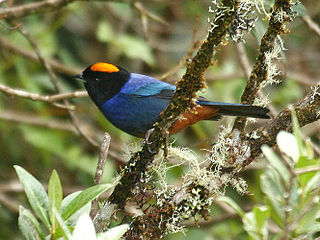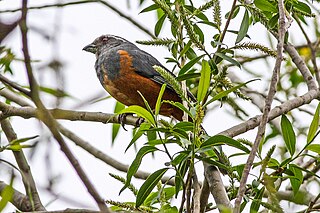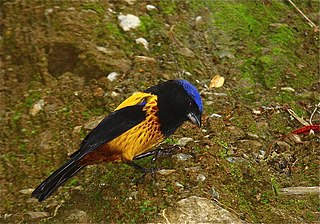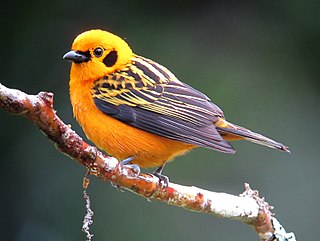
Saltator is a genus of passerine birds in the tanager family Thraupidae that are found in Central and South America. They have thick bills, relatively long tails and strong legs and feet. Before the introduction of molecular genetic methods in the 21st century these species were placed in the cardinal family Cardinalidae.

The grass-green tanager is a small South America bird in the tanager family Thraupidae. It is the only member of the genus Chlorornis.

Tangara is a large genus of birds of the tanager family. It includes 27 species. All are from the Neotropics, and while most are fairly widespread, some have small distributions and are threatened. They are fairly small, ranging in size from 11.5–15 centimetres (4.5–5.9 in). This genus includes some of the most spectacularly colored birds of the world.

Thraupis is a genus of birds of the tanager family occurring from Mexico to Argentina and Brazil. Some are familiar species with large ranges. In Brazil it's called Pipira-azul(pronn: peepeeră, æzoól) when it has a tone blue color, when it has green tone color is called "Pipira-verde" or "Pipira-Vierde" on mexico.

The Inca finches form the genus Incaspiza, of finch-like birds in the tanager family Thraupidae. They were traditionally placed in the family Emberizidae, but molecular phylogenetic studies have shown that they belong in Thraupidae instead. Both their scientific and common name refer to the Incan civilization.

Poospiza is a genus of finch-like birds in the tanager family Thraupidae that are found in both the South American lowlands and the Andes mountains. Generally they are arboreal feeders in light woodland and scrub. All have extensive grey to their plumage, and have—often bold—white or rufous markings.

The pardusco is a species of tanager that is endemic to woodland near the timberline in the Andes of central Peru. It is the only member of the genus Nephelornis. This small olive-brown bird is typically seen in groups, which sometimes join mixed species flocks. It has a small range, but is locally fairly common, and consequently considered to be of least concern by BirdLife International and IUCN.

Iridosornis is a genus of Neotropical birds in the tanager family Thraupidae

Bangsia is a genus of Neotropical birds in the tanager family Thraupidae. They are native to humid forests in Colombia, Ecuador, Panama and Costa Rica.

The rufous-bellied mountain tanager or rufous-bellied saltator is a species of songbird in the tanager family Thraupidae and is the only member of the genus Pseudosaltator. It is found in the eastern Andes of southern Bolivia and extreme northern Argentina. It occurs mostly at altitudes from 3000 m to 4000 m. Its habitat is open land, including cultivated land, that has patches of scrub, alder trees, or Polylepis trees. It is threatened by habitat loss.

The golden-backed mountain tanager is an endangered species of bird in the tanager family. This large and brightly colored tanager is endemic to elfin forests in the Andean highlands of central Peru. It is threatened by habitat loss.

The black-chested mountain tanager is a species of bird in the family Thraupidae.

The masked mountain tanager is a vulnerable species of bird in the tanager family Thraupidae. It is the only member of the genus Tephrophilus. This large and colourful tanager is endemic to elfin forest, woodland and shrub in the Andean highlands of southern Colombia, Ecuador and northern Peru. It is generally rare or uncommon, and is threatened by habitat loss.

The plushcap is a species of bird in the tanager family Thraupidae and it is the only member of the genus Catamblyrhynchus.

Melanospiza is a genus of Neotropical birds in the tanager family Thraupidae.

The golden tanager is a species of bird in the family Thraupidae. It is widespread and often common in highland forests of the Andes and Venezuelan Coastal Range in north-western South America.

The black-capped tanager is one of the many species of Neotropical bird in the family Thraupidae. It lives in mountains of Ecuador, Colombia and Venezuela year-round. This bird can often be found in open landscapes, alone or in pairs, hiding under branches of trees and bushes. Its natural habitats are subtropical or tropical moist montane forests and heavily degraded former forest.

The metallic-green tanager is a species of bird in the family Thraupidae. It is found in Colombia, Ecuador, and Peru. Its natural habitat is subtropical or tropical moist montane forests.

The golden-naped tanager is a species of bird in the tanager family Thraupidae. It is found in South America from Colombia to Bolivia. Its natural habitats are subtropical or tropical moist montane forests and heavily degraded former forest.

Stilpnia is a genus of Neotropical birds in the tanager family Thraupidae.























